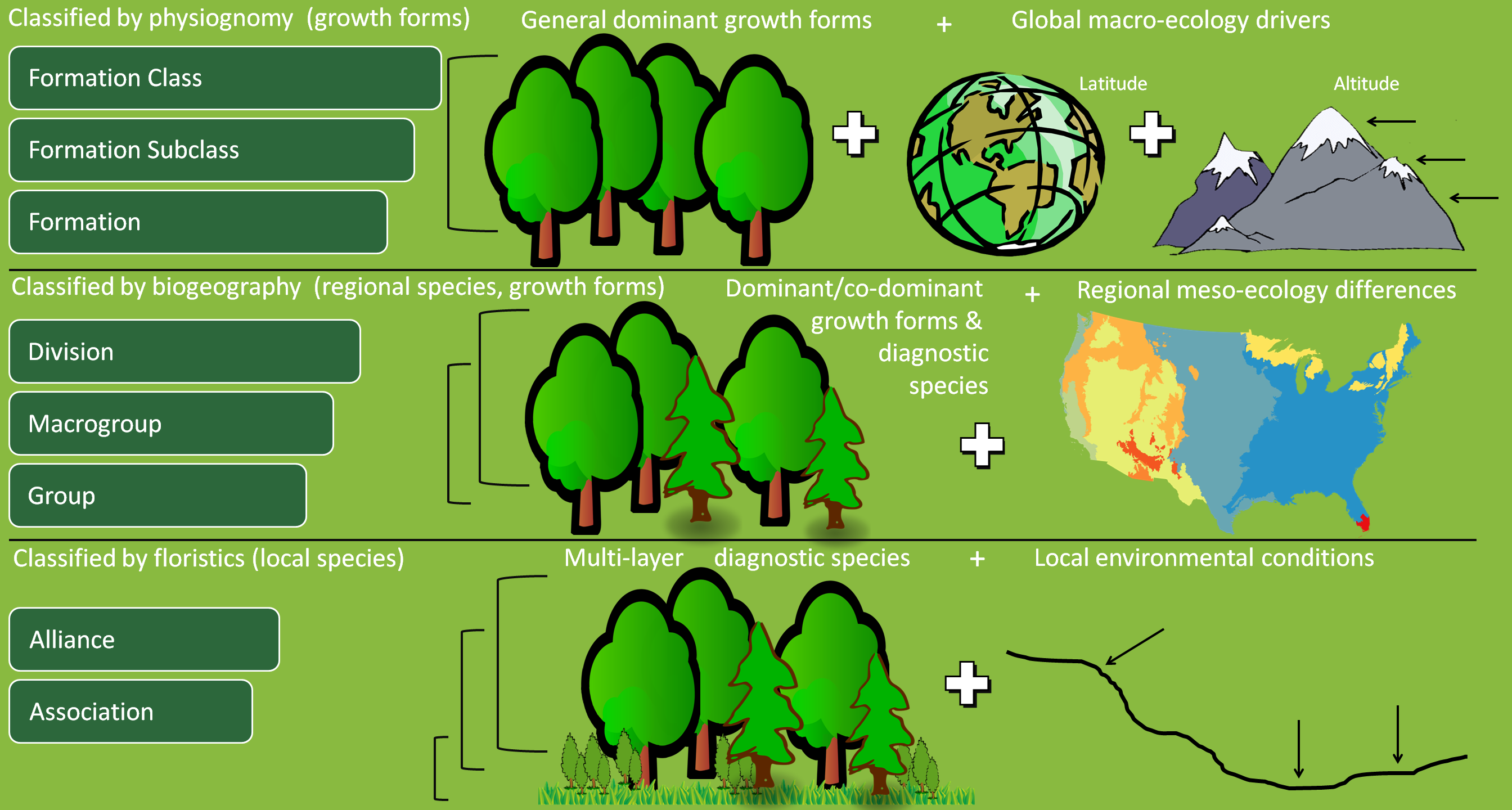Natural (and semi-natural) vegetation is defined as “vegetation where ecological processes primarily determine species and site characteristics”. Human activities may influence vegetation interaction, but do not dominate or remove ecological processes.
The top three levels (class, subclass, formation) are coarse and describe major ecological categories on a global scale. These levels emphasize physiognomy, a combination of the external appearance of vegetation, its vertical structure, and the growth forms of the dominant taxa. The middle levels (division, macrogroup, group) reflect distinctive combinations of species in the context of regional and continental environmental variables and processes such as water cycles and fire patterns. Biogeography and florists are increasingly integrated at the three middle levels. The lowest levels (alliance and association) are the most fine-grained, based on diagnostic and/or dominant species and compositional similarity reflecting local to regional environmental factors.
The relationship between the new hierarchy levels and classification criteria is depicted in the diagram below.

The following table shows criteria and examples of the levels of the revised National Vegetation Classification hierarchy for natural vegetation.
Criteria and examples of the levels of the revised NVC hierarchy for natural vegetation| HIERARCHY FOR NATURAL VEGETATION | VEGETATION CLASSIFICATION CRITERIA | ECOLOGICAL CONTEXT | SCIENTIFIC NAME | COLLOQUIAL NAME |
|---|---|---|---|---|
| Upper Levels | Predominantly physiognomy | |||
| 1 Formation Class | Broad combinations of general dominant growth forms. | Basic temperature (energy budget), moisture, and substrate/aquatic conditions. | Mesomorphic Tree Vegetation Class | Forest & Woodland |
| 2 Formation Subclass | Combinations of general dominant and diagnostic growth forms. | Global macroclimatic factors driven primarily by latitude and continental position, or overriding substrate/aquatic conditions. | Temperate & Boreal Forest & Woodland Subclass | Temperate & Boreal Forest & Woodland |
| 3 Formation | Combinations of dominant and diagnostic growth forms. | Global macroclimatic factors as modified by altitude, seasonality of precipitation, substrates, and hydrologic conditions. | Cool Temperate Forest & Woodland Formation | Cool Temperate Forest & Woodland |
| Middle Levels | Physiognomy, biogeography, and floristics | |||
| 4 Division | Combinations of dominant and diagnostic growth forms and a broad set of diagnostic plant species that reflect biogeographic differences. | Continental differences in mesoclimate, geology, substrates, hydrology, and disturbance regimes. | Pseudotsuga menziesii - Tsuga heterophylla - Tsuga mertensiana Vancouverian Forest & Woodland Division | Vancouverian Cool Temperate Forest & Woodland |
| 5 Macrogroup | Combinations of moderate sets of diagnostic plant species and diagnostic growth forms that reflect biogeographic differences. | Sub-continental to regional differences in mesoclimate, geology, substrates, hydrology, and disturbance regimes. | Calocedrus decurrens - Pinus jeffreyi - Abies concolor var. lowiana Forest Macrogroup | Southern Vancouverian Dry Foothill Forest & Woodland |
| 6 Group | Combinations of relatively narrow sets of diagnostic plant species, including dominants and co-dominants, broadly similar composition, and diagnostic growth forms. | Regional mesoclimate, geology, substrates, hydrology and disturbance regimes. | Quercus garryana - Pinus ponderosa - Pseudotsuga menziesii Forest & Woodland Group | Cascadian Oregon White Oak - Conifer Forest & Woodland |
| Lower Levels | Predominantly floristics | |||
| 7 Alliance | Diagnostic species, including some from the dominant growth form or layer, and moderately similar composition. | Regional to subregional climate, substrates, hydrology, moisture/ nutrient factors, and disturbance regimes. | Quercus garryana - Pinus ponderosa/ Carex geyeri Woodland Alliance | Oregon White Oak - Ponderosa Pine / Geyer's Sedge Woodland Alliance |
| 8 Association | Diagnostic species, usually from multiple growth forms or layers, and more narrowly similar composition. | Topo-edaphic climate, substrates, hydrology, and disturbance regimes | Pinus ponderosa - Quercus garryana / Balsamorhiza sagittata Woodland | Ponderosa Pine - Oregon White Oak/ Arrowleaf Balsamroot Woodland |
A description of each classification concept is available for those levels that have been reviewed.
